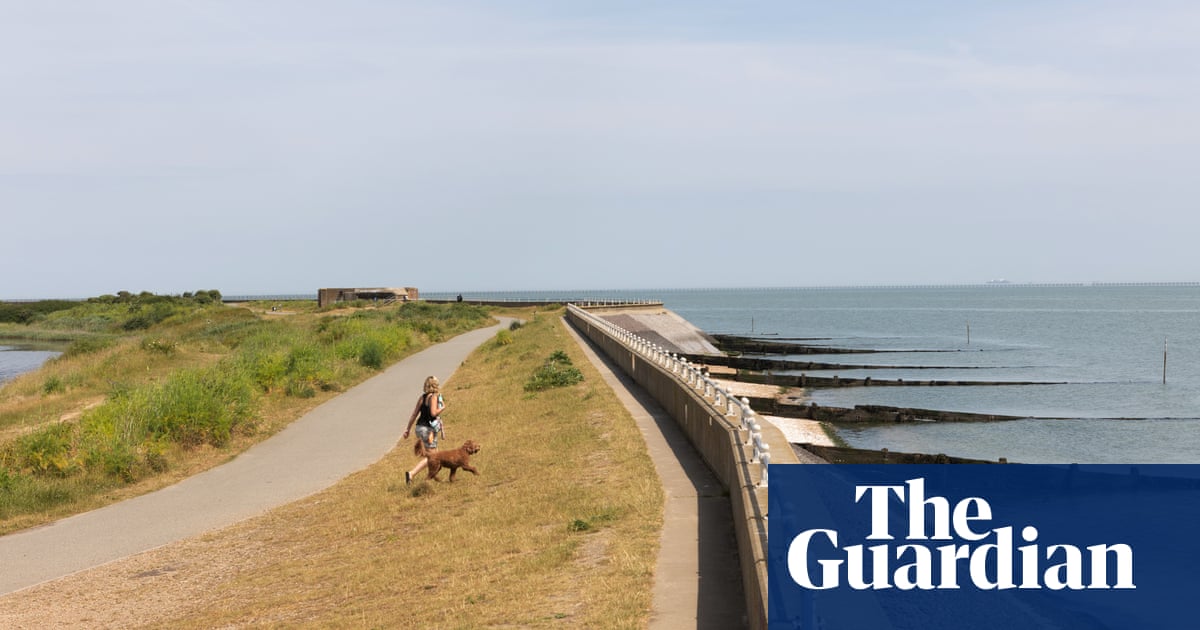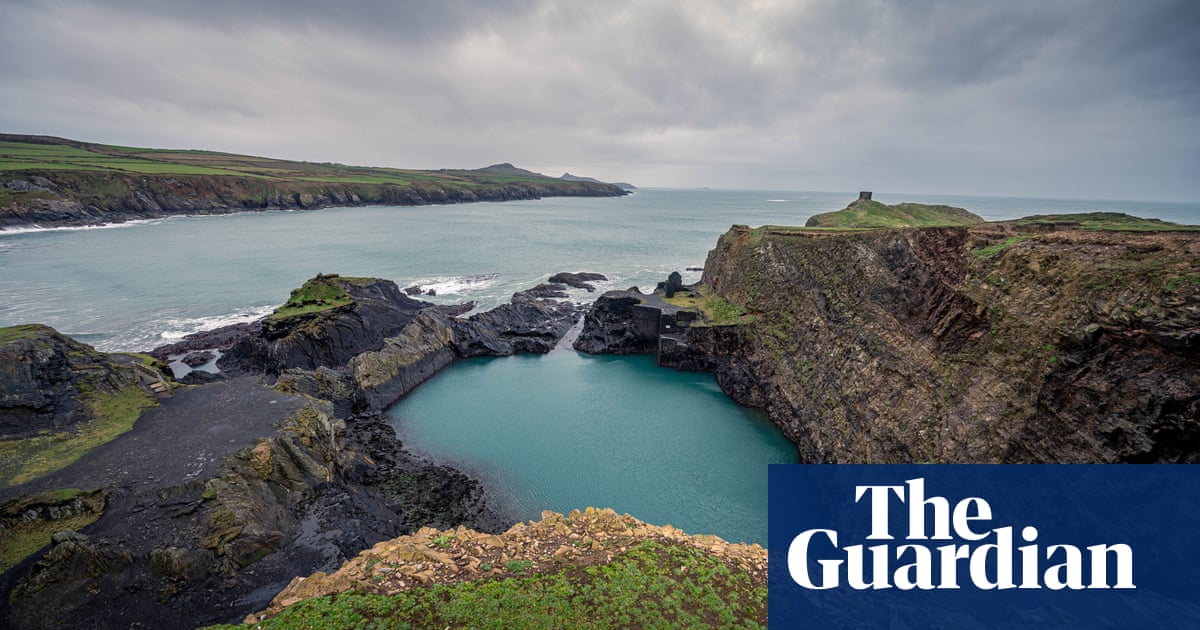
Ihave lived and worked in the north-east of England for almost three decades and explored just about every mile of its coastline. The stretch between the rivers Wear and Tyne is often overlooked, perhaps because it’s partly concealed on the map by the Sunderland and Newcastle conurbation. On previous bike rides and walks I’ve come across old lighthouses, industrial and military relics and other curious features. Now I’ve strung them all together into a route that includes a succession of sandy bays.
I start at Roker, a suburb of Sunderland, and end at the Marsden Grotto in South Shields, a pub with rooms that have been hewn out of the cliff face. It has been significantly upgraded since my previous visit so I’m keen to give it a try.
Swapping the city for sand, I set off on a mild morning, unsure whether to wear one layer or two. I see fishers perched on Roker Pier, which gently arcs out to a lighthouse.
The first curiosity I encounter on the headland before Whitburn Bay is a cast-iron lighthouse whose design was based on a Tuscan column and includes an oriel window. It used to stand on the southern pier at Sunderland but was relocated here in 1983. The tide’s out so I can continue along Seaburn beach, one of the many parts of this coast that have been substantially improved in the past 10 years or so. The rebuilt promenade is now backed by Asian and Italian restaurants as well as stylish new houses with glass-fronted balconies facing the sea.
In contrast, empty fields back the next stretch of coast. Empty, that is, other than their mysterious mounds. They’re reminiscent of neolithic long barrows but are actually the butts of a rifle range erected during the first world war. Opposite the range, Finn’s Labyrinth also gets me thinking. It’s a medieval-style stone puzzle set out in the grass behind a pebbly beach, but I find out later that it was built in 2015 to commemorate the creator’s dog.
There’s no mistaking the next milestone on the route, Souter Lighthouse. Opened in 1871 and now owned by the National Trust, it stands on a headland and, thanks to its elevated position, the tower stands a mere 23 metres high. I make a quick scamper to the top, where the guide tells me how the lights weigh 4½ tonnes and turn on a bed of mercury weighing 1½ tonnes, while the view extends for about 45 miles in every direction. The tower’s red-and-white stripes couldn’t be more fitting to the area given the colours of Sunderland football club.
Magnesian limestone geology characterises the region. As well as providing a habitat for wildflowers (the area is a site of special scientific interest), the limestone also provided a valuable resource. It was quarried at Marsden from the early 19th century, as evidenced by the remains of five giant limekilns looming over the coast road a little further north. They were fuelled by coal from an adjacent colliery, as was the lighthouse, the first in the country to use electric light power from a coal-fired generator. The miners lived in a purpose-built village beside the lighthouse that was demolished in 1968.
The sculpted shape of the coast here is also down to the limestone. Marsden Bay reminds me of Praia da Rocha in Portugal. Cormorants and kittiwakes crowd on to the top of sea stacks and arches in the same density as the holidaymakers who used to pack the beach below, as captured in the old photos I had seen in the recreated lighthouse keepers’ flat.
North of the bay, open fields separate the footpath from the houses of South Shields and give the route more of a rural feel, in keeping with the better-known neighbouring coastlines of Northumberland and North Yorkshire. Signs on the cliff edge and bunches of flowers warn of the dangers of a crumbling coast. What I initially think are numbered posts for a National Trust trail are actually reference points for rescue.
As I near the end of my coastal saunter I pass three tiny beaches. Man Haven bay was once used to launch pilot cobles (small sailing boats) when the sea was too rough to launch from the mouth of the Tyne. Neighbouring Frenchman’s Bay was named after a French ship that ran aground here in the 17th century. The last beach of the trio lies below Trow Point and is crowned by a recreated experimental disappearing gun. The original weapon from the late 19th century was designed to drop below ground so that soldiers could reload out of enemy sight before raising it above ground for firing.
Sadly, and in contrast to most of the other attractions along this coast, the current gun is in a poor state, rusting and sprayed with graffiti. The view makes up for it though, extending to the twin piers tipped by lighthouses that guard the mouth of the Tyne.
The light is starting to fade as I retrace my steps to Marsden Bay, following a narrow path that winds down to the beach, bound for my final destination, Marsden Grotto. There is alternative access from the road via a cliff lift. Built in 1938, the shaft mimics the adjacent sea stack and I wonder if its design was based on lifts at the old colliery. I like the way so many features of this walk are intertwined and rooted in the rock.
“Sorry. No wifi. You’re in a cave!”, reads a sign behind the bar. Customers barely need a reminder of their location. This is an extraordinary dining venue, claiming to be the only rock cave bar in the UK. The grotto dates back to 1782 when a lead miner, Jack the Blaster, set up home in the caves. As well as helping smugglers, he would offer refreshments to visitors who came to see his novel abode. A later owner in the mid-19th century, Peter Allan, who quarried stone for the limekilns, built more rooms into the caves and turned Jack’s house into an inn. In terms of coastal curiosities, I’ve saved the best until last.
Google map of the route
Start Marine Walk car park, Roker
Distance 7½ miles
Time 4 hours
Ascent 124 metres
Difficulty Easy
The pub
Marsden Grotto operates as a pub and a restaurant-with-rooms. There’s a choice of seating: on a terrace with battlements outside, in the bar overlooking the beach or, most intriguingly, tucked away in caves at the back, which used to house a ballroom. My companion and I shared a surfboard platter (£35.95), which included lightly battered cod pieces, crispy whitebait, mackerel pate, pancetta, giant king prawns with heads and tails on, and chunky chips. We didn’t need dessert.
The rooms
Marsden Grotto has 10 modern, well-appointed and comfortable rooms. Features include standalone roll-top baths and classic French-style furniture. All but one of the rooms enjoys a view of the North Sea, but for the full, atmospheric grotto experience, one can choose to sleep within the natural rock walls of the “cave room”, which is set into one of the original caves blasted out in the 18th century.












